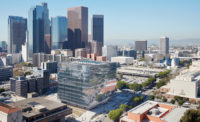Wayne Lyman Morse United States Courthouse
In Eugene, Oregon, Morphosis creates a U.S. Courthouse that provides common ground for people with different points of view
Architects & Firms
Eugene, Oregon
At a time when Americans are deeply divided about the role of government and whether judges should interpret or apply the law, courthouse architecture has become a potential battlefield. No matter what it looks like, every new courthouse—especially one built by the federal government—sends a message about values and political beliefs.

Iconography was very much on the mind of Michael Hogan, the chief judge of the U.S. District Court for the District of Oregon in 1999, when the General Services Administration (GSA) held a design competition for the Wayne Lyman Morse U.S. Courthouse in Eugene. (Hogan is no longer chief judge, but remains on the court.) A conservative jurist appointed by the first President George Bush, Hogan imagined Cass Gilbert’s Supreme Court building in Washington, D.C., whenever he thought of courthouse design. Enter Thom Mayne, the Morphosis principal who flaunts his credentials as a leftist iconoclast and designs buildings whose fragmented forms embody, as he explains, “a lack of completion, an open-ended process.” Natural enemies, Hogan and Mayne locked horns immediately. When Hogan was outvoted and Morphosis won the Eugene courthouse job, the judge couldn’t see how he could ever be comfortable working in a building designed by Mayne. But he set himself the task of engaging Mayne in a discussion of values and ideas, challenging the architect while keeping his own mind open. The two strong-willed individuals had plenty of time to wrestle with issues large and small, as the courthouse site changed and the building didn’t open until December 2006. By then, Hogan and Mayne had become close collaborators, still disagreeing on politics but speaking in one voice about the critical issues expressed in the $78 million, 270,000-square-foot courthouse that stands on the south bank of the Willamette River.
The curving, organic forms of the courtrooms allude to the cedar-clad pods Rogers designed in Bordeaux and establish what Mayne calls a “collective language” for the rest of the building. In an unusual move, Mayne and Groves placed the judges’ chambers above the courtrooms instead of adjacent to them, and inserted pairs of teardrop-shaped courtrooms in three pavilions. As a result, the rooms for judicial proceedings read as distinct forms, announcing their role as the public venue for justice. Wrapped in ribbons of 16-gauge stainless steel brushed with a nondirectional finish (so it won’t create glare), the courtroom pavilions express a fluid attitude to the law (or at least design) that seems to be more Thom Mayne than Michael Hogan.
PeopleOwner Architect: Morphosis project team: Project Manager: Job Captain: Project Designer: Project team: Project Assistants: DLR Group project team: Project Architect: GSA Project Team: Project Executive: Project Manager-Concept Phase: Fire Protection Engineer: Construction Engineer: Financial Manager: Realty Specialist: Property Manager: Interior Designer: Account Manager: Design Competition Jurors: Design Excellence National Peers: Art in Architecture National Peer: Design Architect: Architect of record/ Executive Architect: Interior designer: Engineer(s): Mechanical, Electrical, Plumbing: HVAC and Plumbing: Electrical: Consultant(s) Lighting Consultant: Acoustical Consultant: Collaborative Artists: Blast Consultant: Low Voltage/Audio/Visual: Vertical Circulation: Signage/Graphics: Cost estimator: Code Consultant: Move Coordination: Geotechnical: Fire/Life Safety: Metal Wall Panels: Structural Steel Fabrication: Structural Steel Installation: Earthwork/Sitework: Millwork: Glazing: Fire Protection: Vertical Transportation: Testing/Inspection: Roofing: Mechanical: Drywall: Construction Management: General contractor/ Construction Manager as Constructor: Photographer Renderer CAD system, project management, or other software used:
|
ProductsStructural system: Structure: Metal/glass curtainwall: Concrete: Wood: Roofing Aluminum: Glazing Skylights: Insulated-panel or plastic glazing: Doors Metal doors: Wood doors: Sliding doors: Fire-control doors, security grilles: Special doors (sound control, X-ray, etc.): Hardware Interior finishes Suspension grid: Cabinetwork and custom woodwork: Wallcoverings: Paneling: Special surfacing: Floor and wall tile (cite where used): Resilient flooring: Carpet: Raised flooring: Furnishings Fixed seating: Tables: Lighting Downlights: Exterior: Conveyance Accessibility provision (lifts, ramping, etc.): |



